Page 197 of 223

200ENGINE OIL SELECTION Use API SH, Energy-Conserving IIº mul- tigrade engine oil or ILSAC multigrade en-
gine oil. Recommended viscosity (SAE):
SAE 5W-30 is the best choice for your
vehicle, for good fuel economy and
good starting in cold weather.
If you use SAE 10W-30 engine oil in
extremely low temperatures, the en-
gine may become difficult to start, so
SAE 5W-30 engine oil is recom-mended.
API service symbol
ILSAC certification mark
Oil identification marks
Either or
both API registered marks are
added to some oil containers to help
you select the oil you should use.
The API Service Symbol is located any-
where on the outside of the container. The top portion of the label shows the oil
quality by API (American Petroleum Insti-
tute) designations such as SH. The cen-
ter portion of the label shows the SAE vis-
cosity grade such as SAE 5W-30.
Energy-Conserving IIº shown in the low-
er portion, indicates that the oil has fuel-
saving capabilities. Oils marked Ener-
gy-Conserving IIº will have higher
fuel-saving capabilities than oil marked Energy-Conservingº.
The ILSAC (International Lubricant Stan-
dardization and Approval Committee)Certification Mark is displayed on the front
of the container.
Page 198 of 223
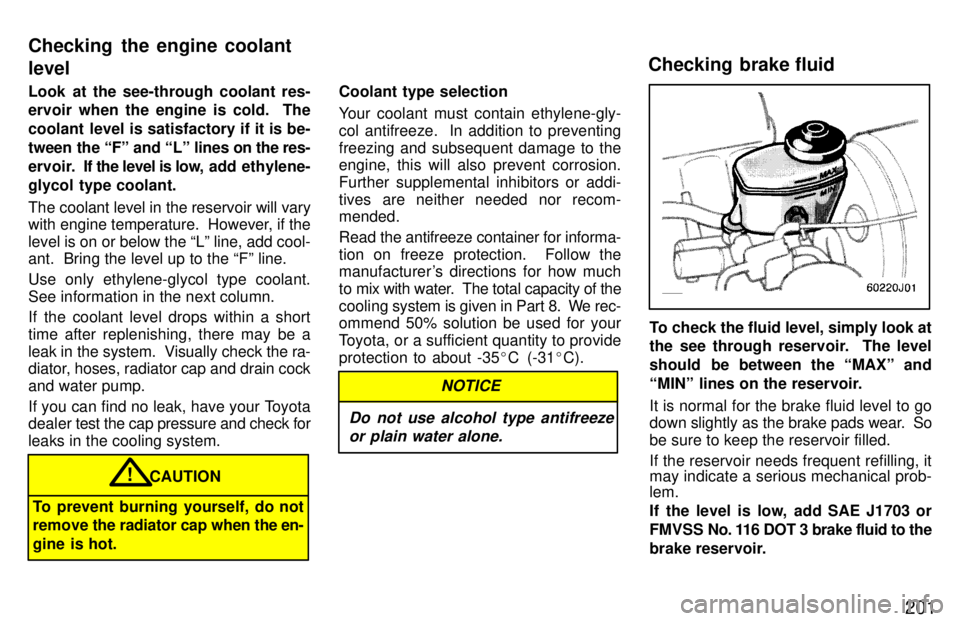
201
Look at the see-through coolant res-
ervoir when the engine is cold. The
coolant level is satisfactory if it is be-
tween the Fº and Lº lines on
the res-
ervoir. If the level is low, add ethylene-
glycol type coolant.
The coolant level in the reservoir will vary
with engine temperature. However, if the level is on or below the Lº line, add cool- ant. Bring the level up to the Fº line. Use only ethylene-glycol type coolant. See information in the next column.
If the coolant level drops within a short
time after replenishing, there may be a
leak in the system. Visually check the ra-
diator, hoses, radiator cap and drain cock
and water pump.
If you can find no leak, have your Toyota
dealer test the cap pressure and check for
leaks in the cooling system.
To prevent burning yourself, do not
remove the radiator cap when the en-
gine is hot.
CAUTION! Coolant type selection
Your coolant must contain ethylene-gly- col antifreeze. In addition to preventingfreezing and subsequent damage to the
engine, this will also prevent corrosion. Further supplemental inhibitors or addi-
tives are neither needed nor recom- mended.
Read
the antifreeze container for informa-
tion on freeze protection. Follow the
manufacturer 's directions for how much
to mix with water. The total capacity of the
cooling system is given in Part 8. We rec-
ommend 50% solution be used for your
Toyota, or a sufficient quantity to provideprotection to about -35 �C (-31 �C).
Do not use alcohol type antifreeze
or plain water alone.
NOTICE
To check the fluid level, simply look at
the see through reservoir. The level
should be between the MAXº and
MINº lines on the reservoir. It is normal for the brake fluid level to go
down slightly as the brake pads wear. So
be sure to keep the reservoir filled. If the reservoir needs frequent refilling, it may indicate a serious mechanical prob- lem.
If the level is low, add SAE J1703 or
FMVSS No. 116 DOT 3 brake fluid to the
brake reservoir.
Checking the engine coolant level
Checking brake fluid
Page 199 of 223
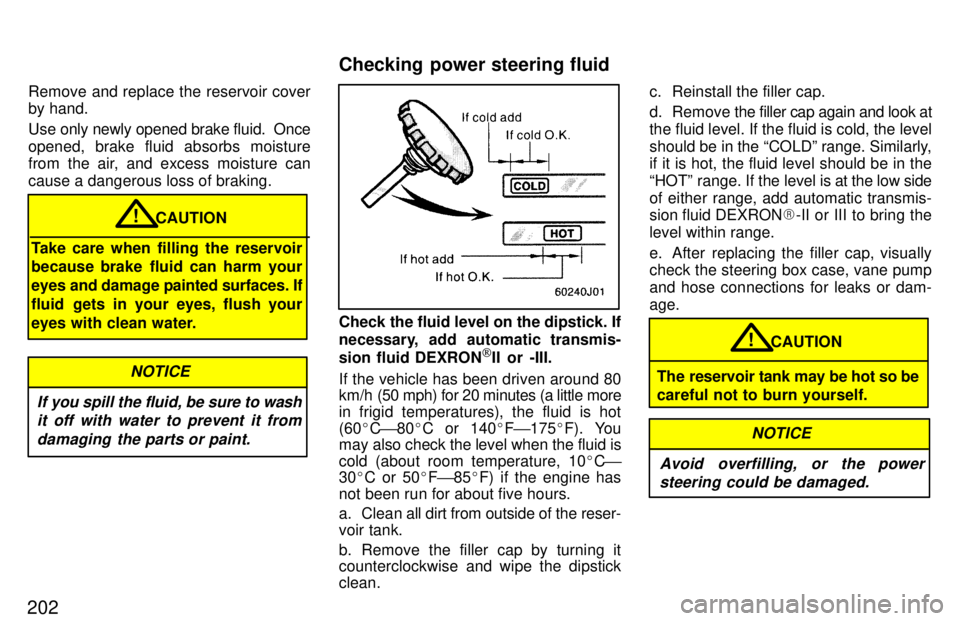
202Remove and replace the reservoir cover by hand.
Use only newly opened brake fluid. Once
opened, brake fluid absorbs moisture
from the air, and excess moisture can cause a dangerous loss of braking.
CAUTION!
Take care when filling the reservoir
because brake fluid can harm your
eyes and damage painted surfaces. If
fluid gets in your eyes, flush your
eyes with clean water.
If you spill the fluid, be sure to wash
it off with water to prevent it from
damaging the parts or paint.
NOTICE
Check the fluid level on the dipstick. If
necessary, add automatic transmis-
sion fluid DEXRON [
II or -III.
If the vehicle has been driven around 80
km/h (50 mph) for 20 minutes (a little more
in frigid temperatures), the fluid is hot (60 �C ' 80 �C or 140 �F ' 175 �F). You
may also check the level when the fluid is
cold (about room temperature, 10 �C '
30 �C or 50 �F ' 85 �F) if the engine has
not been run for about five hours.
a. Clean all dirt from outside of the reser-
voir tank.
b. Remove the filler cap by turning it
counterclockwise and wipe the dipstick clean. c. Reinstall the filler cap.
d. Remove the filler cap again and look at the fluid level. If the fluid is cold, the level
should be in the COLDº range. Similarly, if it is hot, the fluid level should be in the
HOTº range. If the level is at
the low side
of either range, add automatic transmis-
sion fluid DEXRON �-II or III to bring the
level within range.
e. After replacing the filler cap, visually check the steering box case, vane pump
and hose connections for leaks or dam-age.
CAUTION!
The reservoir tank may be hot so be
careful not to burn yourself.
Avoid overfilling, or the power steering could be damaged.
NOTICE
Checking power steering fluid
Page 205 of 223
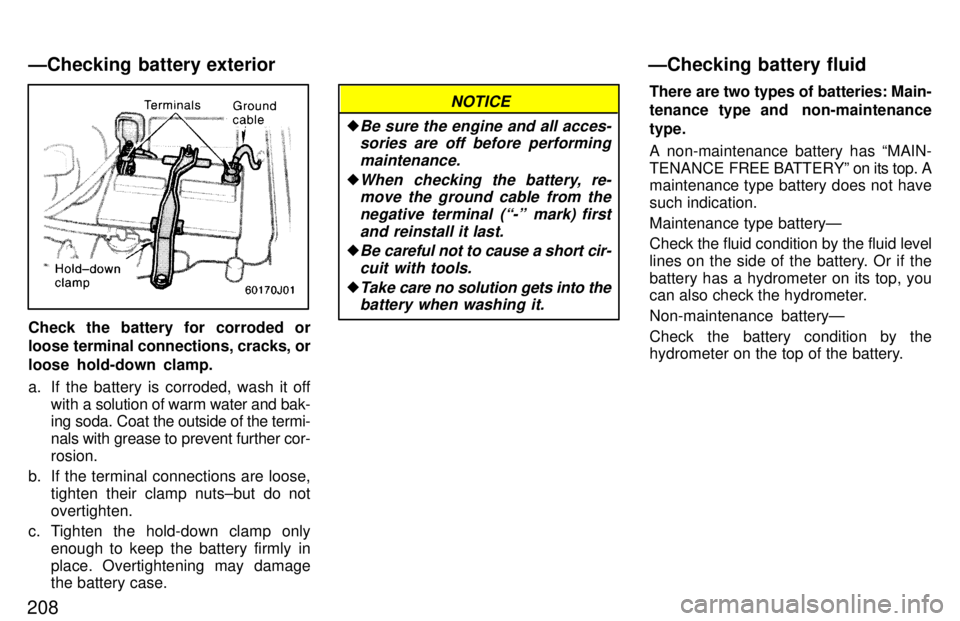
208
Check the battery for corroded or
loose terminal connections, cracks, or
loose hold-down clamp.
a. If the battery is corroded, wash it offwith a solution of warm water and bak-
ing soda. Coat the outside of the termi- nals with grease to prevent further cor-rosion.
b. If the terminal connections are loose, tighten their clamp nuts±but do notovertighten.
c. Tighten the hold-down clamp only enough to keep the battery firmly inplace. Overtightening may damage the battery case.
NOTICE
�Be sure the engine and all acces-
sories are off before performing
maintenance.
�When checking the battery, re-move the ground cable from the
negative terminal (-º mark) first
and reinstall it last.
�Be careful not to cause a short cir-cuit with tools.
�Take care no solution gets into thebattery when washing it.
There are two types of batteries: Main-
tenance type and non-maintenance type. A non-maintenance battery has MAIN-
TENANCE FREE BATTERYº on its top. A
maintenance type battery does not havesuch indication. Maintenance type batteryÐ Check the fluid condition by the fluid level
lines on the side of the battery. Or if the
battery has a hydrometer on its top, you
can also check the hydrometer. Non-maintenance batteryÐ
Check the battery condition by the
hydrometer on the top of the battery.
ÐChecking battery exterior
ÐChecking battery fluid
Page 207 of 223
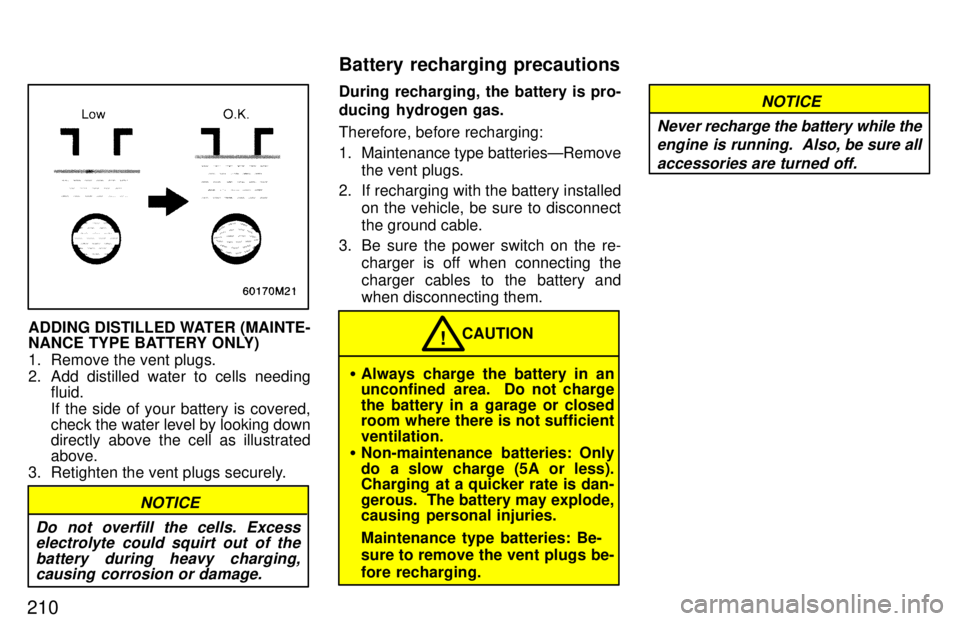
210
ADDING DISTILLED WATER (MAINTE-
NANCE TYPE BATTERY ONLY)
1. Remove the vent plugs.
2. Add distilled water to cells needingfluid.
If the side of your battery is covered,
check the water level by looking down
directly above the cell as illustrated above.
3. Retighten the vent plugs securely.
NOTICE
Do not overfill the cells. Excess electrolyte could squirt out of the
battery during heavy charging,causing corrosion or damage.
During recharging, the battery is pro-
ducing hydrogen gas. Therefore, before recharging:
1. Maintenance type batteriesÐRemove
the vent plugs.
2. If recharging with the battery installed on the vehicle, be sure to disconnect the ground cable.
3. Be sure the power switch on the re- charger is off when connecting the
charger cables to the battery and
when disconnecting them.
�Always charge the battery in an
unconfined area. Do not charge
the battery in a garage or closed
room where there is not sufficient ventilation.
� Non-maintenance batteries: Only
do a slow charge (5A or less).
Charging at a quicker rate is dan-
gerous. The battery may explode,
causing personal injuries. Maintenance type batteries: Be-
sure to remove the vent plugs be-
fore recharging.
CAUTION!
NOTICE
Never recharge the battery while the
engine is running. Also, be sure all
accessories are turned off.
Battery recharging precautions
Page 209 of 223
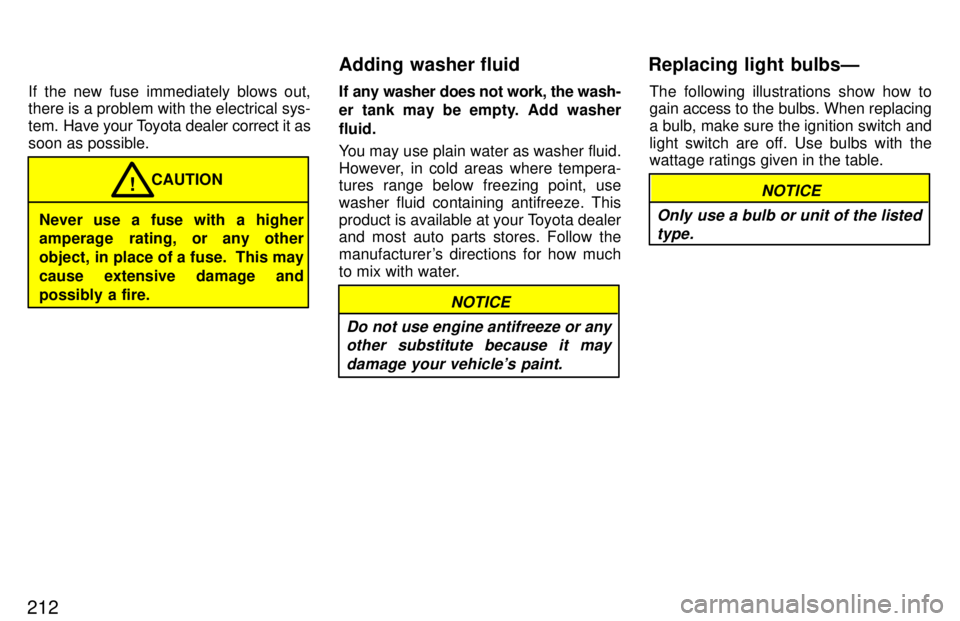
212If the new fuse immediately blows out, there is a problem with the electrical sys-
tem.
Have your Toyota dealer correct it as
soon as possible.
Never use a fuse with a higher
amperage rating, or any other
object, in place of a fuse. This maycause extensive damage and
possibly a fire. CAUTION
!
If any washer does not work, the wash-
er tank may be empty. Add washer fluid.
You may use plain water as washer fluid.
However, in cold areas where tempera-
tures range below freezing point, use
washer fluid containing antifreeze. This
product is available at your Toyota dealer
and most auto parts stores. Follow the
manufacturer 's directions for how much
to mix with water.
NOTICE
Do not use engine antifreeze or any other substitute because it may
damage your vehicle's paint.
The following illustrations show how to
gain access to the bulbs. When replacing
a bulb, make sure the ignition switch and
light switch are off. Use bulbs with the wattage ratings given in the table.
NOTICE
Only use a bulb or unit of the listed type.
Adding washer fluid Replacing light bulbsÐ
Page 214 of 223
P265/70R 16 tire
Without wheel opening extension With wheel opening extension
P225/75R 15 tire
Overall length Overall widthOverall heightWheel base Front tread Rear tread 4540 (178.7)1690 ( 66.5)1715 ( 67.5)*2675 (105.3) 1505 ( 59.3) 1495 ( 58.9) 4540 (178.7)1730 ( 68.1)1760 ( 69.3)*2675 (105.3) 1505 ( 59.3) 1510 ( 59.4)4540 (178.7)1800 ( 70.9)1760 ( 69.3)*2675 (105.3) 1505 ( 59.3) 1510 ( 59.4)
Cargo weight rating kg (lb.): 200 (300)
*: Unladen vehicle mm (in.)
Part 8
Dimensions and weight
217
SPECIFICATIONS �
Dimensions and weight
�Engine
�Fuel
�Service specifications
�Tires
�Fuses
Page 215 of 223

+25 -15
218
Model:
3RZ-FE and 5VZ-FE
Type: 3RZ-FE engine4 cylinder in line, 4 cycle, gasoline
5VZ-FE engine 6 cylinder V type 4 cycle, gasoline
Bore and stroke, mm (in.):
3RZ-FE engine95.0 x 95.0 (3.74 x 3.74)
5VZ-FE engine
93.5 x 82.0 (3.68 x 3.23)
Displacement, cm 3
(cu. in.):
3RZ-FE engine
2694 (164.3)
5VZ-FE engine 3378 (206.1) Fuel type:
Unleaded gasoline, Research OctaneNumber 91 (Octane Rating 87) or higher
Fuel tank capacity, L (gal., Imp. gal.):
70 (18.5, 15.4) ENGINE
Valve clearance (engine cold), mm (in.)
3RZ-FE engine
Intake 0.15 '0.25 (0.006 '0.010)
Exhaust 0.25 '0.35 (0.010 '0.014)
5VZ-FE engine
Intake 0.13 '0.23 (0.006 '0.009)
Exhaust 0.27 '0.37 (0.011 '0.014)
Spark plug type:
3RZ-FE enginesNIPPONDENSO K16R-U
NGK BKR5EYA
5VZ-FE engine
NIPPONDENSO K16TR11
NGK BKR5EKB11
Spark plug gap, mm (in.): 3RZ-FE engine 0.8 (0.031)
5VZ-FE engine 1.1 (0.043)
Drive belt tension measured with Bor-
roughs drive belt tension gauge No.
BT-33-73F (used belt), lbf: 3RZ-FE engineGenerator belt 115 + 20
Air conditioning compressor belt 100 + 20
Power steering pump belt 100
Service specifications
Fuel
Engine